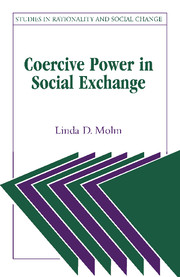Book contents
- Frontmatter
- Contents
- LIST OF FIGURES AND TABLES
- PREFACE AND ACKNOWLEDGMENTS
- 1 Introduction and overview
- 2 Social exchange and power
- 3 Punishment and coercion
- 4 An experimental setting for studying power in exchange relations
- 5 The early research: experimental tests and theoretical puzzles
- 6 The structural determination of power use
- 7 Dependence and risk: structural constraints on strategic power use
- 8 Injustice and risk: normative constraints on strategic power use
- 9 The effects of coercion: compliance or conflict?
- 10 A theory of coercion in social exchange
- 11 Conclusions and implications
- APPENDIX I Definitions of basic concepts of social exchange
- APPENDIX II The experimental instructions for the standardized setting
- REFERENCES
- NAME INDEX
- SUBJECT INDEX
4 - An experimental setting for studying power in exchange relations
Published online by Cambridge University Press: 06 July 2010
- Frontmatter
- Contents
- LIST OF FIGURES AND TABLES
- PREFACE AND ACKNOWLEDGMENTS
- 1 Introduction and overview
- 2 Social exchange and power
- 3 Punishment and coercion
- 4 An experimental setting for studying power in exchange relations
- 5 The early research: experimental tests and theoretical puzzles
- 6 The structural determination of power use
- 7 Dependence and risk: structural constraints on strategic power use
- 8 Injustice and risk: normative constraints on strategic power use
- 9 The effects of coercion: compliance or conflict?
- 10 A theory of coercion in social exchange
- 11 Conclusions and implications
- APPENDIX I Definitions of basic concepts of social exchange
- APPENDIX II The experimental instructions for the standardized setting
- REFERENCES
- NAME INDEX
- SUBJECT INDEX
Summary
Experimental research, especially in laboratory settings, is relatively rare in the social sciences. Common criticisms of laboratory experiments (e.g., artificiality, lack of random sampling, irrelevance for real-world situations) suggest that their role in building and testing theories is not well understood. Consequently, in addition to describing the basic experimental setting used in this program, this chapter explains the theoretical logic that underlies experimentation in general, and this setting in particular. I begin with a brief discussion of the purpose of laboratory experiments and why artificiality is an advantage rather than a disadvantage for the task of this book: constructing and testing a theory of coercive power in social exchange. Then, I turn to a detailed description and explanation of the experimental setting I use for this task.
Laboratory experiments and theory construction: descriptive versus formal theory
Most criticisms of laboratory experiments are based on the assumption that the purpose of social science research is to obtain findings that can be generalized to natural settings and specific populations. Research on power, for example, should tell us something about power in families, in organizations, or in international relations. If so, then the more the research setting resembles famines, organizations, or international relations, the more likely that our findings would apply to those settings. Thus, the obvious and enormous disparities between characteristics of those settings, and characteristics of an experimental setting in which undergraduate subjects sit in small isolated rooms, making choices on computers that produce small increments or decrements of money for other undergraduate subjects (which, as I discuss in a moment, is the kind of setting used for this research), make experiments seem trivial and irrelevant.
- Type
- Chapter
- Information
- Coercive Power in Social Exchange , pp. 74 - 102Publisher: Cambridge University PressPrint publication year: 1997

